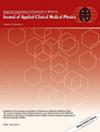Robust deep learning-based patient-specific quality assurance prediction models for novel dual-layer MLC linac
Abstract
Purpose
This study investigates the feasibility of utilizing deep learning models to robustly predict patient-specific quality assurance (PSQA) outcomes in fixed field intensity-modulated radiation therapy (FF-IMRT) plans on the Halcyon linear accelerator equipped with a novel dual-layer multi-leaf collimator (MLC). The study explores the integration of Shuffle Attention (SA) mechanisms and deep imbalance regression techniques to enhance the precision and robustness of deep learning-based PSQA predictions. It ensures relative prediction robustness in the extreme imbalance distribution of gamma passing rate (GPR) values.
Methods
Data from 214 FF-IMRT treatment plans covering various treatment sites comprising 1394 beam orientations and corresponding Portal Dosimetry verification data were collected. Fluence maps calculated for each beam orientation served as inputs for the ResNet model. First, the SA module was introduced to improve the prediction accuracy of ResNet, resulting in the proposed Att-ResNet model. Furthermore, to ensure prediction robustness in the GPR values with extreme imbalance distribution, we incorporated the Label Distribution Smoothing (LDS) technique, ultimately forming the ALDS-ResNet method.
Results
ALDS-ResNet exhibited smaller mean absolute error (MAE) values than ResNet across all gamma criteria (1%/1 mm: 2.035 vs. 1.824, 2%/2 mm: 1.416 vs. 1.178, 3%/3 mm: 0.951 vs. 0.787). ALDS-ResNet also demonstrated lower MAE values than ResNet for complex but important plan samples (GPR < 85, 1%/1 mm: 10.163 vs. 4.985, 2%/2 mm: 7.443 vs. 3.272, 3%/3 mm: 5.031 vs. 2.940). Compared to ResNet, ALDS-ResNet achieved higher Pearson correlation coefficient (CC) values at 2%/2 mm and 3%/3 mm gamma criteria, measuring 0.7864 and 0.7852, respectively.
Conclusions
The deep learning model based on ResNet shows promise for predicting GPR values in linacs with dual-layer MLC. Integrating attention mechanisms with deep learning networks enhances the accuracy of PSQA predictions. The LDS technique is attributed to the substantial improvement in failed plan GPR prediction accuracy and robustness. Specifically, the deep learning model tailored for dual-layer MLC linacs can be an auxiliary tool for physicists in identifying PSQA failure plans.


 求助内容:
求助内容: 应助结果提醒方式:
应助结果提醒方式:


